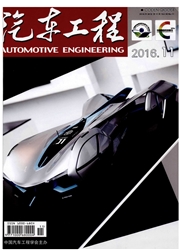

 中文摘要:
中文摘要:
本文旨在通过综合分析车辆正面碰撞加速度波形和约束系统的关键设计参数,研究提高乘员胸部保护性能的途径。首先基于某车型正面100%刚性墙碰撞实验,建立并验证了正面碰撞下的乘员动态响应的MADYMO多体运动学模型;再以C—NCAP中乘员胸部损伤评价指标(胸部压缩变形量和胸部合成加速度)最小化为优化目标,以大型、小型和微型轿车3种车型中不同的前舱溃缩空间,以及双梯形加速度波形的第1和第2台阶加速度、发动机参与碰撞时刻、安全带刚度和限力器限力值作为设计变量与约束,采用正交实验设计和多目标遗传算法进行优化。结果表明,3种车型在C—NCAP正面100%刚性墙碰撞中的胸部保护得分率都有明显的提高。
 英文摘要:
英文摘要:
The ways to improve the occupant chest protection performance of passenger car are studied in this paper by comprehensively analyzing the wave forms of frontal crash accelerations and key design parameters. Firstly a MADYMO multi-body kinematics model for occupant dynamic response under frontal crash is built and verified based on full frontal crash test of a car against rigid wall. Then with minimizing the occupant chest injury criteria (chest compression deformation and resultant chest acceleration) as objectives, different front-end collapse spaces for large-, medium-and micro-cars as well as the accelerations of first and second steps in dual trapezoid acceleration curve, the moment of engine participating in crash, the stiffness of seat belt and the force limit of load limiter as design parameters and constraints, an integrated optimization is conducted by using orthogonal experimen- tal design and multi-objective genetic algorithm. The results indicate that the C-NCAP scores of chest protection in full front impact against rigid wall for all 3 types of car obviously rise.
 同期刊论文项目
同期刊论文项目
 同项目期刊论文
同项目期刊论文
 期刊信息
期刊信息
